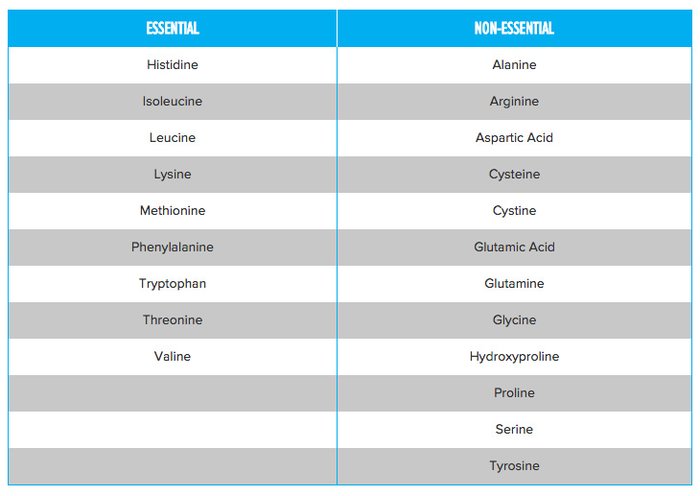Protein is one of the most important substances we consume. After this article you will know how much protein your body needs. The function it plays in survival, the way it is processed and used.
Other than water, protein is the most abundant nutrient in the body. Protein is a chain of linked units called amino acids. The protein you eat is split apart into these amino acids, absorbed in the small intestines, then rearranged and put back in the blood stream. These new arranged proteins carry out specific functions to maintain life. All living tissues are made up of twenty-two essential and nonessential amino acids.
Essential amino acids are not made by the body and must be supplied through diet. There are nine essential amino acids: Histidine, Isoleucine, Leucine, Lysine, Methionine, Phenylalanine, Threonine, Tryptophan, and Valine. The remaining thirteen are nonessential amino acids produced in the body and not essential to consume through the diet.
Twenty-two in all, amino acids are divided into 2 groups:

Protein provides four calories per gram. The human body can do three things with protein calories; put protein in fat stores, use it as an energy source or use it to carry out functions vital to life. Protein calories will be used as an energy source when the body is lacking fat or carbohydrate calories for fuel. When the body receives sufficient quantities of proteins, fats and carbohydrates, protein will carry out its specific functions. These proteins functions include: replacement of old cells, building muscles, organs, blood, nails, hair, skin, and tissues. Protein also takes part in hormone, antibodies, and enzyme formation.
Fasting your body without proper protein intake will cause your body to slowly start shutting down. You must not only eat enough protein, but you must eat the right types. Without the right amount of essential proteins, no matter how much you eat, your body will waste the protein and not run properly.
A diet that is low in essential amino acids does not carry out all of its protein functions. Protein follows the all-or-none law: inadequate amounts of essential amino acids cause the body to excrete proteins in urine as urea. The remainder of the protein is converted to glucose, fat, or metabolized for energy. This lack of essential amino acids prevents proteins from performing their normal functions. Foods that have all nine of the essential amino acids are called complete proteins. Complete proteins include all food from animal products, milk, cheese, chicken, beef, and ext. Don't worry folks! Proteins that are incomplete (plant products) can be combined with complementary proteins that carry the missing amino acids to form a complete protein. Examples of incomplete protein are grains, cereals, and vegetables. To complement these proteins you would combine beans with grains, or nuts with cereal.
Now that you have an understanding of the right kinds of protein to eat, we will discuss how many grams you need to eat.
In Understanding Normal and Clinical Nutrition, the Authors say, "The Committee on Dietary Allowances of the Food Nutrition Board of the National Academy of Sciences states the RDA in grams of protein per kilogram of body weight per day" (Whitney 153). If calories are sufficient in carbohydrates and fat, You divide your body weight by 2.2, this gives your weight in kilograms. You multiply your kilogram weight by 0.8, this gives you your daily intake of protein. A person who weighs 95 kilograms (210 pounds), would take 95 kilograms times 0.8. Their daily protein intake would work out to be around 77 grams, 12% of your calories would come from protein.
We do know that long bouts of exercising increases the need for nutrients, especially protein. In Nutrition For Fitness and Sport with Powerweb the author says, "A number of studies involving endurance athletes found that 0.97-1.37 grams of protein per kilogram per day were needed." (Williams 112).
Carbohydrates: The Body's Preferred Source Of Energy
Are carbohydrates the bodies preferred source of energy? By the time you finish reading this article you will understand the bodies need, function and the roles carbohydrates play in our nutrition. We start our discussion by comparing complex and simple carbohydrates.
Complex carbohydrates include bread, pasta and cereals. They are digested at a slower rate than simple carbohydrates. This slower digestion offers a more continual and stable flow of energy. Simple carbohydrates deliver the same amount of energy, four calories per gram, but at a far more rapid pace. Therefore, simple carbohydrates provide an immediate boost in blood sugar. But the boost comes with a price—it wears off quickly and more is needed to sustain blood sugar levels.
As a result, excess food cravings are experienced and may cause individuals to increase their calorie consumption. Thus, simple carbohydrates should be avoided within your diet. They include sugar, honey, soda and candy.
Sugar and carbohydrates are broken down into smaller versions called glucose. All cells in the human body depend on glucose. This makes carbohydrates the body's number one energy source. The brain and nervous system run directly off glucose. The human body will convert protein to glucose without enough carbohydrates in the diet. Carbohydrates spare other nutrients (protein), and allow these nutrients to carry out their intended functions.
Carbohydrates offer a thermogenic effect that will increase calorie burning. This will cause your body to burn more calories every time you eat. If your diet is high in fat, the fat is put faster into storage. To top if off, fat is much harder to take out of lipid (fat) stores and used as energy. Carbohydrates on the other hand, use 23 percent of consumed calories to store carbohydrates. In contrast, fat uses only 3 percent of consumed calories.
Carbohydrates should make up 50% to 60% of your calories. The majority of your calories should come from complex carbohydrates. Less then ten percent of your calories should come from refined sugars. This will decrease low blood sugar, increase energy expenditure, increase satiety and satisfaction. Carbohydrates are glucose, glycogen, sugar, starches, fiber, cellulose and various saccharides.
In plain English, complex carbohydrates are the most desirable because they burn more slowly. Foods such as breads made from whole grains, fruit in its natural state (raw), and raw vegetables are examples of excellent carbohydrates.
Fat: The Misunderstood Nutrient
Fat is the world's most misunderstood nutrient! Everyone has told you about how bad excess fat is in your diet. In fact, this is discussed so much that the positive effects of fat is seldom ever brought up. Fat has many functions that people overlook. Without enough fat in your diet, you will not be able to support good health. You say I'm crazy, well I'm not, it's true!
Lipids is the scientific term used for fat. Lipids have over twice as many calories per gram as carbohydrates or protein, offering a great energy source. Lipids are divided into categories; Cholesterol is an example of saturated fat.
Saturated fats remain solid at room temperature, are found in animal sources, coconut, palm oil and in excess are linked to heart disease. Unsaturated fat are found in oils and plants. These unsaturated fats stay in the form of a liquid at room temperature. These fats found in oils and plants make up the essential fat you body needs through diet called linolaic acid.
Linoleic acid cannot be manufactured by the body, thus, it is an essential fatty acid that must be supplied through the diet. Fat accomplishes many things: It gives us energy for activities, providing nine calories per gram, surrounds and protects vital organs, takes part in cellular function and structure, gives a longer lasting feeling of satiety, regulates hormonal production, balances body temperatures, and transport fat soluble vitamins.
Fat is the last nutrient to digest and leave the stomach. This supplies a delayed feeling of satisfaction after eating. Once the fat arrives in the small intestine, bile produced by the pancreas comes in contact with the fat further breaking it up into smaller droplets. This process is called emulsification. Once the fat has been emulsified enzymes attach to the fat splitting it further apart. When the body has fully split apart the fat into glycerol, fatty acids and monoglycerides, the smaller versions are absorbed into the blood stream to be stored or carry out specific functions.
Fat intake should make up less than 30% of your daily calories, depending on individual preference, energy levels, and speed of digestion. For your body to receive the essential fat intake it requires, 3% of fat intake should come from Linoleic acid. For the safety of your heart, cholesterol should be limited to 300 milligrams a day.
References
- Grodstein, Francine. Levine, Rachel. Spencer,Terri. Colditz, Graham A. Stampfer, Meir J. "Three-year follow-up of participants in a commercial weight loss program: can you keep it off?" Archives of Internal Medicine 24 June. 1996: v156 n12 p1302 (5).
- Jirbrin, Janis. "The Protein Diet That Really Works." Family Circle 1 Feb. 1999:v112 i2 p68(1). Nutrition Concepts and Controversies. West Publishing Company: New York, 1978.
- "The Secret of High-protein diets; what you need to know before you give up pasta (includes evaluations of popular high-protein diets)." Prevention June 1997: v49 n6 p85(7).
- Tribole, Evelyn. "Which weight loss programs work best?" Consumers Digest Sep- Oct 1996:v35 n5 p71(4).
- Vreeland, Leslie. Maroukian, Francine. Town & Country Monthly June 1996: v150 n5193 p150(2). Ward, Elizabeth M. "Winnowing weight-loss programs to find a match for you." Environmental Nutrition Jan 1998: v21 n1 pl(3).
- Whitney, Eleanor Noss., III, et al, Understanding Normal and Clinical Nutrition. New York: West Publishing Company 1991.
- Williams, Melvin H., Nutrition for Fitness and Sport, William C. Brown Company Publishers, Iowa: 1983.
- Nutrition Concepts and Controversies. West Publishing Company: New York, 1978.
- Mattfeldt-Beman, Mildred. Corrigan, Sheila A. Stevens, Victor J. Sugars, CarolynP. Dalcin, Arlene T. Givi, M. John. Copeland, Karen C. Journal of the American Dietetic Association Jan. 1999: v99 il p66(6).
- Tribole, Evelyn. "Which weight loss programs work best?" Consumers Digest Sep- Oct 1996:v35 n5 p71(4).
- Whitney, Eleanor Noss., III, et al, Understanding Normal and Clinical Nutrition. New York: West Publishing Company 1991.
- Williams, Melvin H., Nutrition for Fitness and Sport, William C. Brown Company Publishers, Iowa: 1983.* Mattfeldt-Beman, Mildred. Corrigan, Sheila A. Stevens, Victor J. Sugars, Carolyn P. Dalcin, Arlene T. Givi, M. John. Copeland, Karen C. Journal of the American Dietetic Association Jan. 1999: v99 il p66(6).
- The Secret of High-protein diets; what you need to know before you give up pasta (includes evaluations of popular high-protein diets)." Prevention June 1997: v49 n6 p85(7).
- Whitney, Eleanor Noss., III, et al, Understanding Normal and Clinical Nutrition. New York: West Publishing Company 1991.

